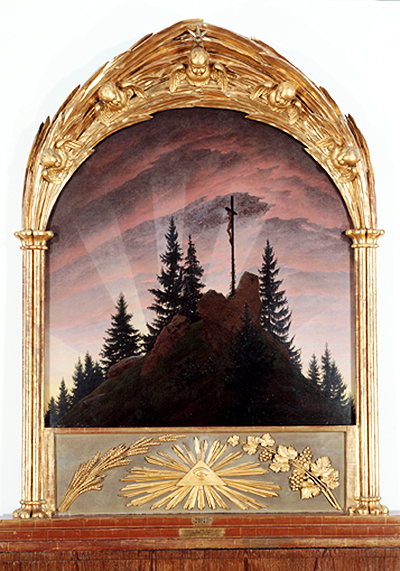Caspar David Friedrich created Cross in the Mountains, also called the Altar, in 1807. It is said to be one of the earliest paintings that he made of landscapes where he lived. Like many of his paintings, it was an oil painting on canvas. The painting is currently housed at Galerie Neue Meister at Dresden, Germany.
Cross in the Mountains was created on the political and religious standpoints. It was more of a two-dimensional form that could be explained in either way. He used a limited colour palette and did some loose brushwork. However, the image created feelings of nationalism and religious piety in many of those that saw the image. The image is a two-dimensional one that lacks any definitive special depth effects. This goes a long way to add some mystic feel to the image. It shows a rock pyramid, tips of trees and a set of expanding rays that seem to point to the sky rather downwards. A figure of Christ is seen on the cross, looking towards the setting sun.
It is not easy to determine the viewer’s standpoint in the image as one moves from the treetops to the image on the cross. Here is the place where one sees the magnitude and the feel of the image. At the bottom of this frame is the Eye of God, a symbol of the Holy Trinity. The palm tree images look like pillars with the leaves ending in a pointed arch and what looks like angel heads. There is also a silver star on one of the angel heads.
David first executed the painting in sepia before adding colour to the image. However, he did not entirely cover the sepia as the deep reds on the clouds and foreground as dark brown shadows still show the sepia. He works the light intelligently to illuminate the entire image and reflect some through the trees and even the statue while still ensuring that the sun is obscured. The rays are geometric in nature and distances from one ray to the other are of equal distances.
As a religious painting, it represented the holy deity and invoked a sombre tone that is similar to what one would feel when he or she walks into a church. It is also a reflection of the sufferings of Christ and how he brought light into the darkness that had covered the earth.
However, to political analysts, the image represented Germany, which had fallen as Jesus did. It was a prediction that Germany will rise again to her feet and become a leading nation as it once did. This explanation came to be from the political upheavals that were happening at the time. The explanation was also seen as valid after the defeat of German in both World Wars. David used the Romanticism style of painting in this landscape image. The style emphasized on stillness, beauty of nature and emotions into all the images. David became one of the leading artists in this style of painting.




